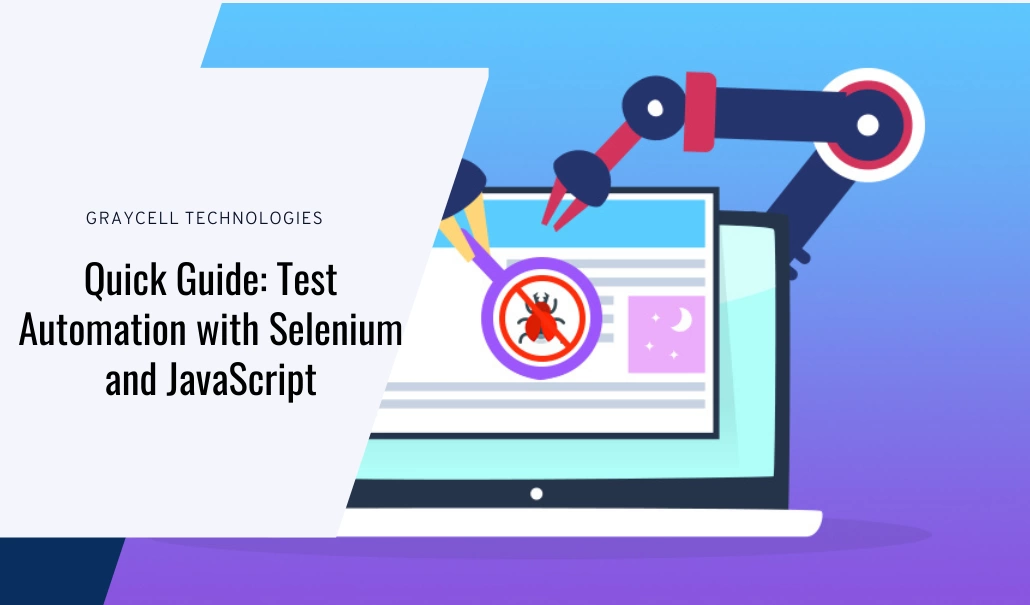Automation testing is an essential part of the software development life cycle and is crucial for ensuring your product is as good as you want it to be. The primary goal of automation testing is to uncover the maximum number of bugs and deliver a successful product release.
Nowadays, testing has become more vital when it comes to web applications. It is necessary to perform automation testing because it ensures a flawless experience for the end-user with accurate results. There are a lot of automation testing tools available, but Selenium is the most feasible framework because it supports a wide range of scripting languages, including JavaScript. Selenium runs on most modern operating systems like Windows, Linux, and macOS.
What is Selenium

Selenium is one of the most popular and widely used open-source tools that automate web browsers. It supports automation across different platforms and browsers. It lets you write test scripts in programming languages like JavaScript (NodeJS), Ruby, Java, PHP, etc., and can be run directly in a modern web browser like Google Chrome, Safari, and Mozilla Firefox.
It is further categorized as:
- Selenium IDE: Selenium Integrated Development Environment (IDE) is a Firefox and Chrome plugin that one can use to automate web actions. Keep in mind that the plugin is quick and the code generated is too complicated to be used in automation test scripts. So it is good for rapid prototyping, but for complex cross-browser testing you can use Selenium WebDriver.
- Selenium WebDriver: Also known as Selenium 2.0, Selenium WebDriver is a web framework that accepts commands from language binding and forwards them to a browser. It also permits you to execute cross-browser tests. Selenium WebDriver is able to handle window components, but to overcome this drawback, you can use tools like Auto IT and Sikuli.
- Selenium Grid: Selenium Grid is a tool that specializes in running multiple tests across multiple virtual or physical machines in parallel. It dramatically speeds up the testing process across web browsers and platforms. Selenium Grid is a hybrid of a hub and a set of nodes.
- The Hub (server): The hub can also be called a server. It acts as the central point from which the tests will be set off. A Selenium Grid supports only one hub and it is launched on a single machine once.
- Node (remote device): − Nodes are the different browsers connected to a single hub. There can be a couple of nodes in a grid that can be on any operating system and can use any of the Selenium-supported browsers.
Why Selenium Automation Testing Using JavaScript?

There are lots of frameworks and tools available in the market for automation testing. But Selenium is the first choice of QA engineers over the past decade.
Features of Selenium web automation are:
- Open-source and portable.
- Supports a wide range of web browsers like Mozilla Firefox, Safari, Google Chrome, and many more.
- Supports a wide range of programming languages like PHP, Javascript, Java, Python, Ruby, and many more.
- Supports multiple Operating systems like Windows, macOS, Linux, etc.
- Easy to integrate with continuous integration and continuous delivery (CI/CD) like CircleCI, GitLab CI, and many more.
- Easy to integrate with famous testing frameworks.
Why Choose JavaScript for Selenium Based UI automation?
JavaScript is very well known in the field of web application development. As per the survey of Stack Overflow, JavaScript is the most widely used programming language in the world. Since it is used by a large section of web developers, integrating it to enhance the test automation with Selenium is a good idea. Here are a few points that highlight why you should choose JavaScript with Selenium:
- JavaScript is a well-developed programming language that makes automation scripts more readable and easy to understand.
- These technologies are free to use and are open source.
- It is wrapped with advanced security and is completely safe to use.
- JavaScript is a scripting language that can directly control both client-side and server-side scripting.
Top Four JavaScript Testing Frameworks
1. JEST
JEST is an automation testing framework built on JavaScript and developed by Facebook, designed to test JavaScript code for applications developed using React JS. The Jest framework helps the developer validate functions that are using JavaScript, whether it is browser rendering of mobile applications or web applications. That’s why it has been considered a very well documented and fast-performing JavaScript testing framework.
2. Nightwatch
Nightwatch open-source automated testing framework built in node.js, that simplifies the integration. It offers end-to-end testing of a web application with the help of Selenium WebDriver API. Night watch can be used for both integrating testing and unit testing. It has an inbuilt command-line test runner for testing.
3. Protractor
Protractor is used for Angular JS-based web applications. It is an open-source testing framework written in Node.js. Protractor is primarily used for end-to-end testing of Angular web applications. It is easy to set up parallel execution of test cases against different environments, and supports both Angular and Non-Angular applications.
4. Mocha
Mocha is an open-source JavaScript test framework for Node.js programs. It operates on node.js and is used mostly by JavaScript developers for unit testing and integration testing. It also provides compatibility for both backend and frontend testing. One thing that makes it different from others is its accurate reporting and providing a node.js debugger that makes error identification easier.
Conclusion
In this blog, we learned about the basic aspects of Selenium web automation with JavaScript. Automation testing is a key driver for business and helps to find the bugs and dig out the missing requirements for a successful product delivery. Automation testing utilizing Selenium with JavaScript has made life more straightforward for web application developers and testers. It has demonstrated support and given an upgraded method of testing. Please feel free to contact us in case you have any questions or feedback regarding this article.






